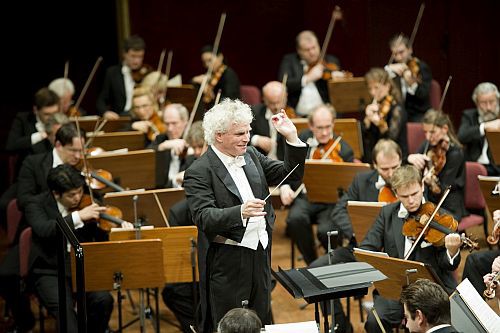 United Kingdom Widmann, Lutosławski, Brahms: Berliner Philharmoniker / Sir Simon Rattle (conductor). Royal Festival Hall, London, 31.5.2018. (CC)
United Kingdom Widmann, Lutosławski, Brahms: Berliner Philharmoniker / Sir Simon Rattle (conductor). Royal Festival Hall, London, 31.5.2018. (CC)

Jörg Widmann – Tanz auf dem Vulkan (UK premiere, 2018)
Lutosławski – Symphony No.3 (1983)
Brahms – Symphony No.1 in C minor, Op.68
Intended as something of a condensed retrospective of the Rattle era, and part of his final tour as Chief Conductor of the BPO, this was a beautifully balanced programme. Perhaps that is why no encore was offered after the Brahms?
Rattle has long been identified with contemporary music, of scores with the ink still wet – at least, back in the day when composers used ink – and so it was that we began with the UK premiere of composer/clarinettist Jörg Widmann’s Tanz auf dem Vulkan (‘Dance on the Volcano’) which received its world premiere in Berlin’s Philharmonie on May 27, and was commissioned to mark Sir Simon’s departure from the BPO’s helm. The Berlin Philharmonic has previously championed Widmann’s music via the World Premiere of Trauermarsch for piano and orchestra (Yefim Bronfman, Rattle) and the European Premiere of Flûte en suite (Pahud/Rattle); both of those performances are available on the Berlin Philharmonic’s Digital Concert Hall.
Widmann’s piece is full of wit and yet has a decidedly explosive aspect. It begins without conductor, the brass and percussion of the Berlin orchestra channelling a big band, before the conductor enters, on this occasion hands in pockets, feigning indifference. From then on Widmann’s piece, splendidly anarchic, vociferously chthonic, morphs into something far more complex. Sudden Romantic gestures attempt to surface before being subsumed into the flow, dance elements zoom in and out of focus; more than once the layered, strata-defined world of Charles Ives was invoked. Rattle is asked to exit the stage before the piece finishes, mirroring his entrance. All this in less than ten minutes, offering a fitting display of contemporary fireworks, all handled with the expected aplomb by the Berliners. Widmann has the ability to reference a variety of musics all within a coherent overall voice. A concert dedicated to Jörg Widmann at the very top of this year at the Wigmore Hall was testament to his talent and again included a UK premiere, that time of Es war einmal (review). Interested readers may wish to seek out the recording of Es war einmal on the Myrios label; then perhaps enhance the experience further with a disc of Widmann’s five string quartets (like Schoenberg, one includes a soprano: Juliane Banse in the case of the fabulous Dabringhaus und Grimm recording with the Leipzig String Quartet).
Lutosławski’s Third Symphony has long held a fascination for Sir Simon. The piece itself has something of a tangled gestation. It was actually commissioned by the Chicago Symphony Orchestra in 1974, but one false start led to another until finally, in a spurt of activity in 1981-83, the piece was born. The big aural signpost of the work is a sequence of repeated E naturals (this is a home pitch-class, not a home key, it is important to state): those repeated Es seemed a touch muted, even restrained, here, perhaps too burnished to be fully articulative. The work is a masterpiece, of that there is no doubt, and certainly Rattle has no qualms. The controlled aleatorism, so characteristic of Lutosławski, emerged as entirely natural to the Berlin players, who found huge beauty in the score. Horn chords were masterfully blended; strings could be remarkably glacial while long string melodies, when they came, were powerfully expressive. The processional towards the end, led by two horns, seemed to exude particular potency.
Another symphony of long gestation, Brahms’ First returned us to familiar turf. Rattle recorded a cycle of Brahms symphonies in the Philharmonie in 2008; there, as here, the first movement exposition repeat was omitted (see John Quinn’s review). Rattle’s interpretative decisions seem constant, as John also refers to the eschewing of Brahms’ hairpin crescendo-diminuendos in the expansive horn calls towards the beginning of the finale, clearly there in the MS and once more absent on this occasion (and, by extension, absent when the woodwind take over the theme).
The sheer heft of the Berlin sound – few if any compromises to authenticity here – is remarkable; so it was that the intensity of the Un poco sostenuto opening was visceral, the strings hyper-sostenuto, and no hard sticks for the timpani. Oboist Albrecht Mayer’s solos here set the standard for the woodwind throughout, perfectly judged: in fact, the interaction between Meyer and the principal flute, Emmanuel Pahud, was one of the unalloyed joys of the performance. Rattle’s sound was built from the bass up, and yet counterpoint remained clear. He understood the ebb and flow of the music while maintaining a firm structural grasp.
Albrecht Mayer’s contributions to the Andante sostenuto were simply glorious; later, the woodwind choir proved itself with perfectly in-tune chords (reminding us how rarely it is one hears that level of care); concertmaster Daniel Strabawa’s violin solos were beautifully sweet. The dappled light and shade of the Un poco allegretto e grazioso morphed to an invocation of a darkened forest through which those Urwald horn calls of the finale emerged. No missing the richness of the Berlin strings in the ‘big tune’ of that finale, nor the sense of carefully sculpted arrival at the coda.
A potent evening, a marrying of two distinct sides of Rattle, the contemporary/modern and the mainstream.
Colin Clarke
